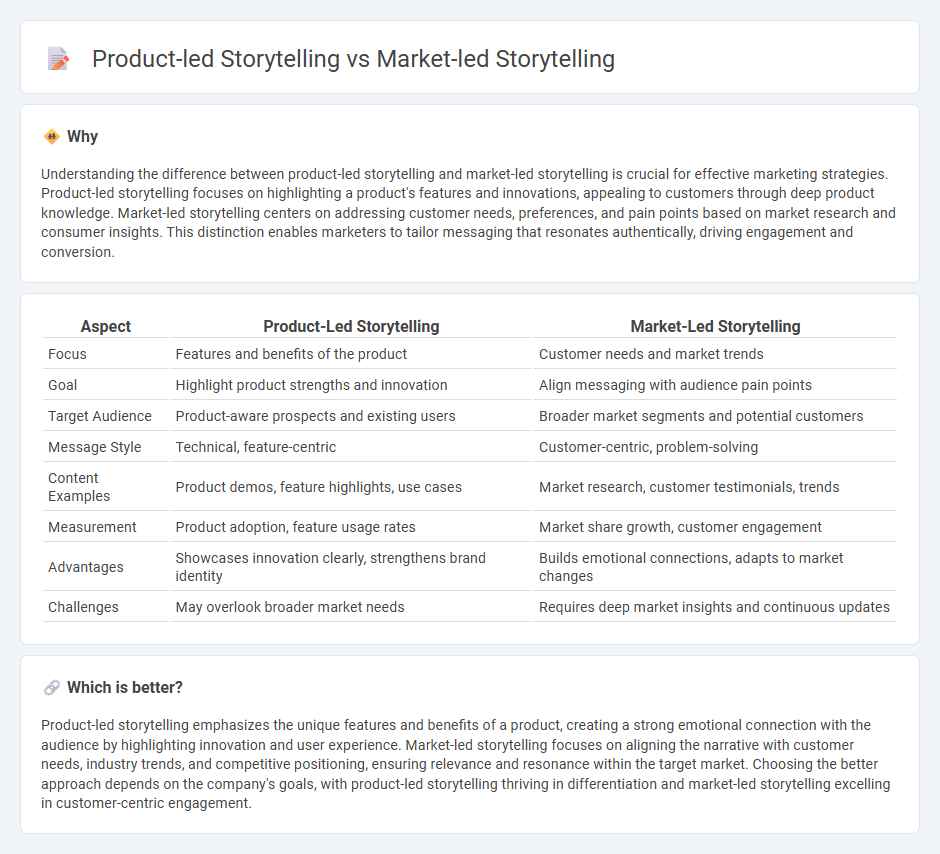
Product-led storytelling centers on highlighting a product's unique features and innovation to engage customers, emphasizing tangible benefits and user experience. Market-led storytelling focuses on understanding customer needs, market trends, and competitive landscape to craft narratives that resonate emotionally and solve specific problems. Explore how these storytelling approaches can transform your brand strategy and drive business growth.
Why it is important
Understanding the difference between product-led storytelling and market-led storytelling is crucial for effective marketing strategies. Product-led storytelling focuses on highlighting a product's features and innovations, appealing to customers through deep product knowledge. Market-led storytelling centers on addressing customer needs, preferences, and pain points based on market research and consumer insights. This distinction enables marketers to tailor messaging that resonates authentically, driving engagement and conversion.
Comparison Table
| Aspect | Product-Led Storytelling | Market-Led Storytelling |
|---|---|---|
| Focus | Features and benefits of the product | Customer needs and market trends |
| Goal | Highlight product strengths and innovation | Align messaging with audience pain points |
| Target Audience | Product-aware prospects and existing users | Broader market segments and potential customers |
| Message Style | Technical, feature-centric | Customer-centric, problem-solving |
| Content Examples | Product demos, feature highlights, use cases | Market research, customer testimonials, trends |
| Measurement | Product adoption, feature usage rates | Market share growth, customer engagement |
| Advantages | Showcases innovation clearly, strengthens brand identity | Builds emotional connections, adapts to market changes |
| Challenges | May overlook broader market needs | Requires deep market insights and continuous updates |
Which is better?
Product-led storytelling emphasizes the unique features and benefits of a product, creating a strong emotional connection with the audience by highlighting innovation and user experience. Market-led storytelling focuses on aligning the narrative with customer needs, industry trends, and competitive positioning, ensuring relevance and resonance within the target market. Choosing the better approach depends on the company's goals, with product-led storytelling thriving in differentiation and market-led storytelling excelling in customer-centric engagement.
Connection
Product-led storytelling focuses on showcasing the unique features and benefits of a product to engage customers, while market-led storytelling emphasizes understanding customer needs and market trends to shape the narrative. Both approaches intertwine by aligning product value propositions with market demands, creating a cohesive message that resonates with target audiences. This synergy enhances brand positioning, drives customer engagement, and ultimately boosts sales performance through tailored storytelling strategies.
Key Terms
Customer-Centric
Market-led storytelling centers on customer needs, preferences, and pain points, crafting narratives that align with market trends and consumer behavior to foster emotional connections. Product-led storytelling highlights product features, innovations, and benefits, aiming to demonstrate how the product solves specific problems or enhances user experiences. Explore deeper insights into customer-centric storytelling strategies to effectively boost engagement and brand loyalty.
Value Proposition
Market-led storytelling emphasizes aligning narratives with customer needs, pain points, and market trends to highlight the value proposition effectively, fostering stronger emotional connections and trust. Product-led storytelling focuses on showcasing product features, innovations, and benefits, demonstrating how the product solves specific problems or improves user experience. Explore more to understand which strategy best amplifies your value proposition and drives customer engagement.
Brand Narrative
Market-led storytelling emphasizes understanding customer needs, market trends, and competitive landscape to craft a brand narrative that resonates deeply with target audiences. Product-led storytelling, on the other hand, centers around highlighting unique product features, innovations, and benefits to build brand identity and customer trust. Explore how integrating these approaches can strengthen your brand narrative and drive customer engagement.
Source and External Links
What Product-Led Storytelling Is And How It Drives User Acquisition - Product-led storytelling is a marketing approach in SaaS where stories demonstrate how a product solves users' challenges, helping drive user acquisition and engagement by showing real-life success cases like Mailchimp and Ahrefs.
8 Exceptional Examples of Customer-Led Storytelling - ClearVoice - Customer-led storytelling focuses on amplifying customers' authentic experiences and stories to create impactful brand connections, leveraging social platforms for wider sharing and engagement.
Storytelling in marketing: Crafting messages that stick - Mural - Market-led storytelling builds trust and inspires action through emotional, relatable narratives, with notable examples like Dove's "Real Beauty" and Spotify Wrapped demonstrating how brands use storytelling to deepen engagement and boost growth.
 dowidth.com
dowidth.com